

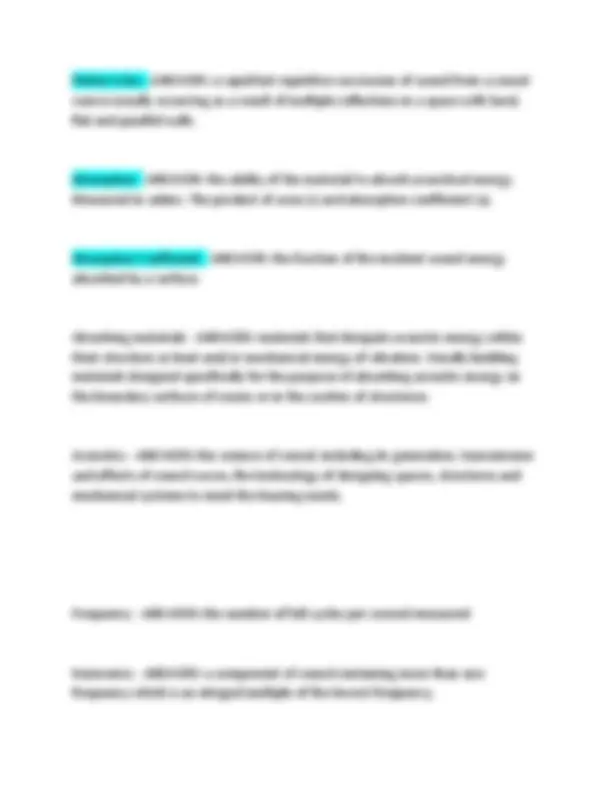
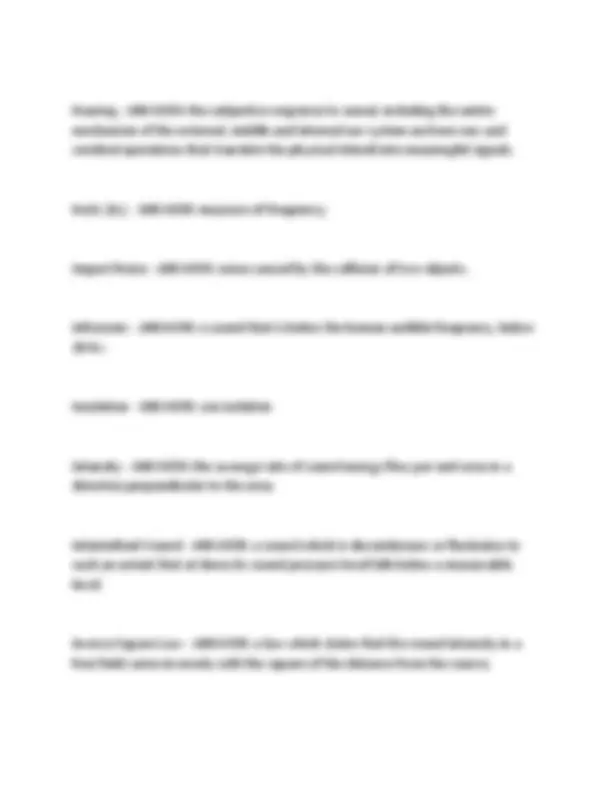
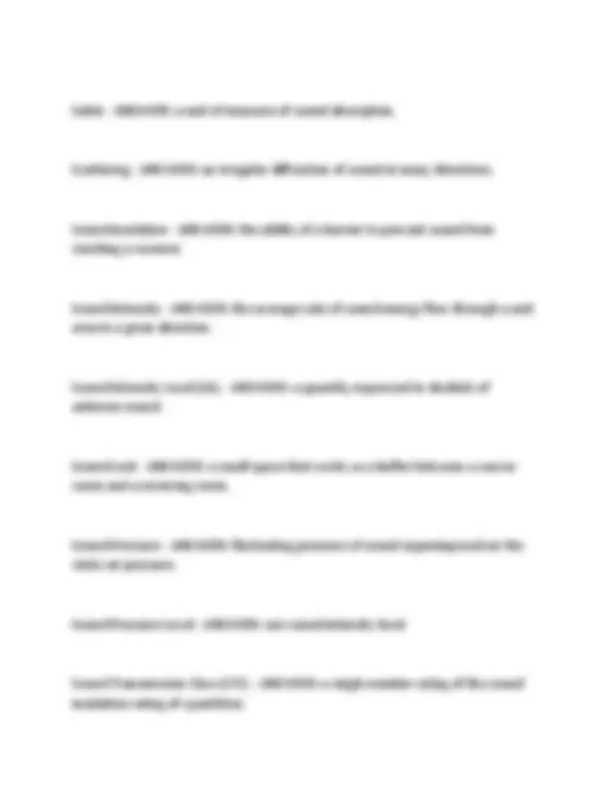
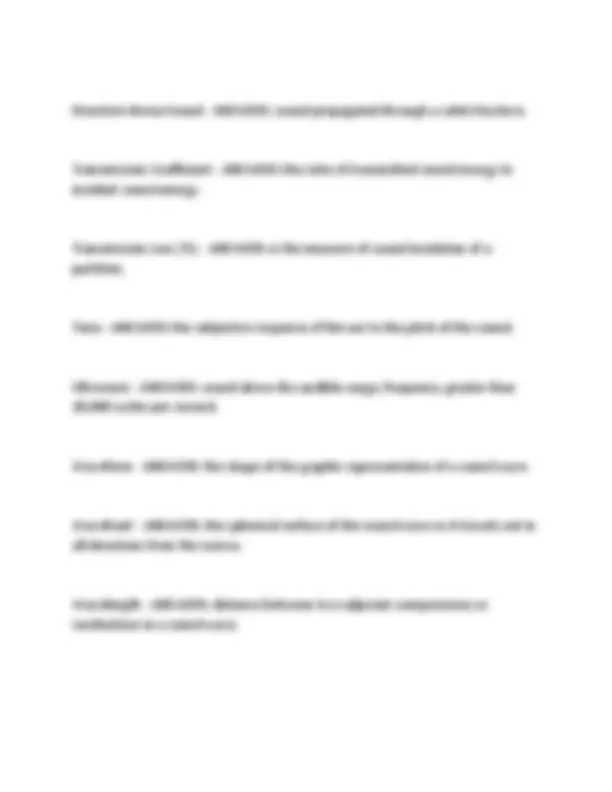

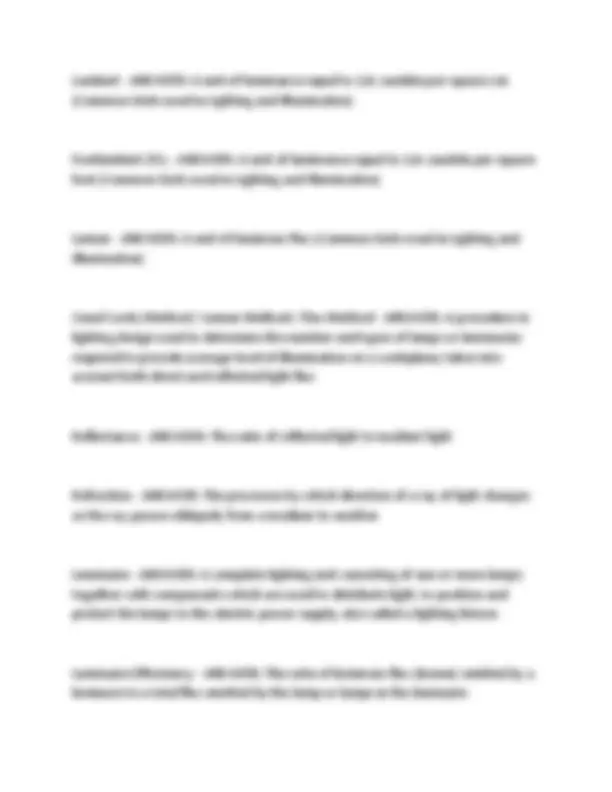
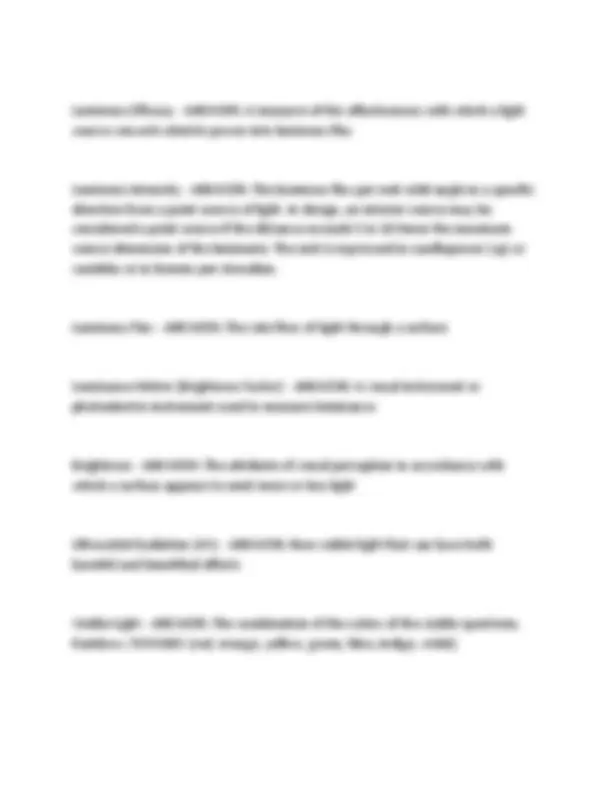
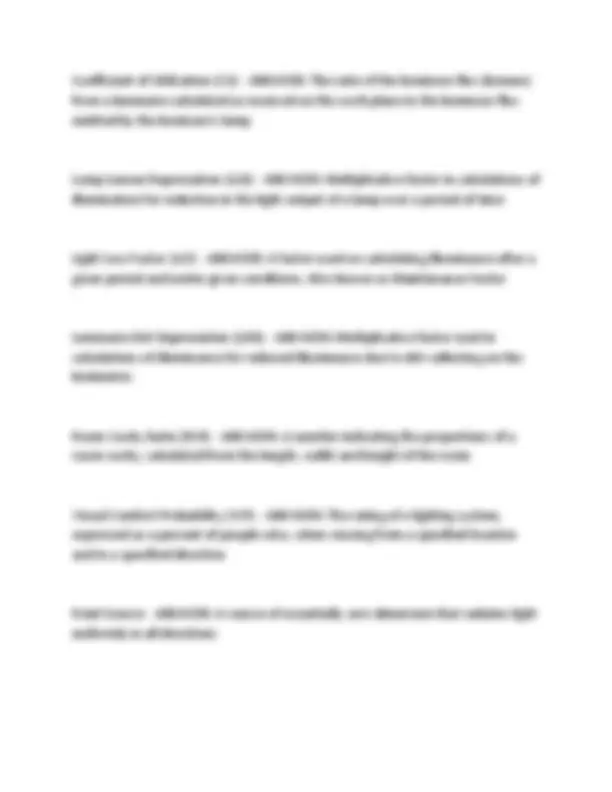


Study with the several resources on Docsity

Earn points by helping other students or get them with a premium plan


Prepare for your exams
Study with the several resources on Docsity

Earn points to download
Earn points by helping other students or get them with a premium plan
Community
Ask the community for help and clear up your study doubts
Discover the best universities in your country according to Docsity users
Free resources
Download our free guides on studying techniques, anxiety management strategies, and thesis advice from Docsity tutors
A comprehensive glossary of terms related to acoustics and lighting. It defines key concepts such as sound absorption, reverberation, and illumination, offering a valuable resource for students and professionals in the field. Well-organized and easy to navigate, making it a useful tool for understanding the fundamentals of acoustics and lighting.
Typology: Exams
1 / 16

This page cannot be seen from the preview
Don't miss anything!










Brilliance - ANSWERS-The clarity, strength and brightness of a color
Contrast - ANSWERS-The difference in brightness between an object and its background
Glare - ANSWERS-The sensation produced by luminance within the visual field that is sufficiently greater than the luminance to which the eyes are adapted. This may cause annoyance, discomfort or loss of visual performance or visibility
Direct Glare - ANSWERS-Glare resulting from high luminance or insufficiently shielded light sources in the field of view
Discomfort Glare - ANSWERS-Glare producing discomfort. This type of glare does not necessarily interfere with visual performance or visibility
Emissivity (A perfect black body has an emissivity of 1, a perfect reflector an emissivity or 0.) - ANSWERS-The ratio of radiant energy emitted by a body to be emitted by a perfect black body.
Infrared Radiation (IR) - ANSWERS-Non-visible light characterized by its relation to heat
Anechoic Chamber - ANSWERS-a sealed room in which all the surfaces are designed to completely absorb all sound produced in the room.
Attenuation - ANSWERS-a reduction in sound level. Sound attenuation in air- conditioning is specified in terms of dB per meter.
Background Noise - ANSWERS-ambient noise
Break-in Noise - ANSWERS-transfer of noise from a space surrounding the duct into the duct through duct walls.
Break-out Noise - ANSWERS-transfer of noise from the interior of a duct through duct walls into a space outside the duct.
Creep - ANSWERS-transmission of sound along the curve.
Flutter Echo - ANSWERS-a rapid but repetitive succession of sound from a sound source usually occurring as a result of multiple reflections in a space with hard, flat and parallel walls.
Absorption - ANSWERS-the ability of the material to absorb acoustical energy. Measured in sabins. The product of area (s) and absorption coefficient (a).
Absorption Coefficient - ANSWERS-the fraction of the incident sound energy absorbed by a surface.
Absorbing materials - ANSWERS-materials that dissipate acoustic energy within their structure as heat and/or mechanical energy of vibration. Usually building materials designed specifically for the purpose of absorbing acoustic energy on the boundary surfaces of rooms or in the cavities of structures.
Acoustics - ANSWERS-the science of sound, including its generation, transmission and effects of sound waves; the technology of designing spaces, structures and mechanical systems to meet the hearing needs.
Frequency - ANSWERS-the number of full cycles per second measured
Harmonics - ANSWERS-a component of sound containing more than one frequency which is an integral multiple of the lowest frequency.
Hearing - ANSWERS-the subjective response to sound, including the entire mechanism of the external, middle and internal ear system and nervous and cerebral operations that translate the physical stimuli into meaningful signals.
Hertz (hz) - ANSWERS-measure of frequency.
Impact Noise - ANSWERS-noise caused by the collision of two objects.
Infrasonic - ANSWERS-a sound that is below the human audible frequency, below 20 Hz.
Insulation - ANSWERS-see isolation
Intensity - ANSWERS-the average rate of sound energy flow per unit area in a direction perpendicular to the area.
Intermittent Sound - ANSWERS-a sound which is discontinuous or fluctuates to such an extent that at times its sound pressure level falls below a measurable level.
Inverse Square Law - ANSWERS-a law which states that the sound intensity in a free field varies inversely with the square of the distance from the source.
Noise Reduction Coefficient (NRC) - ANSWERS-a single number rating derived from measured values of sound absorption coefficients of a material at 250, 500, 1000 and 2000 Hz.
Outdoor-Indoor Transmission Class (OITC) - ANSWERS-a weighted single number rating of the sound reduction effectiveness of a partition that separates an indoor space from the outside.
Pitch - ANSWERS-a listener's perception of the frequency of a pure tone.
Reflection Coefficient - ANSWERS-a measure of the sound reflective property of a surface.
Resonance - ANSWERS-the relatively large amplitude of vibration produced when the frequency of the source of sound is equal to the natural frequency of a room.
Reverberant Sound Field - ANSWERS-a sound field created by repeated reflections of sound from the boundaries in an enclosed space.
Reverberation - ANSWERS-the continuation of sound in an enclosed space after the initial source has been terminated.
Reverberation Time (RT) - ANSWERS-the time it takes for sound intensity to decay by 1 millionth of its steady state value after the sound source has been terminated.
Sabin - ANSWERS-a unit of measure of sound absorption.
Scattering - ANSWERS-an irregular diffraction of sound in many directions.
Sound Insulation - ANSWERS-the ability of a barrier to prevent sound from reaching a receiver.
Sound Intensity - ANSWERS-the average rate of sound energy flow through a unit area in a given direction.
Sound Intensity Level (SIL) - ANSWERS-a quantity expressed in decibels of airborne sound.
Sound Lock - ANSWERS-a small space that works as a buffer between a source room and a receiving room.
Sound Pressure - ANSWERS-fluctuating pressure of sound superimposed on the static air pressure.
Sound Pressure Level - ANSWERS-see sound intensity level
Sound Transmission Class (STC) - ANSWERS-a single number rating of the sound insulation rating of a partition.
White Noise - ANSWERS-a noise whose energy is uniform over a wide range of frequencies. This is analogous to the term "white light", which consists of almost equal amount of light of different wavelength (colors). A white noise sounds hissy.
Tinnitus - ANSWERS-is caused by high-pitched ringing in the ears. This is experienced by some people exposed to machinery and other high pitched sound sources. This condition may last a short while.
Nosocusis - ANSWERS-A short term exposure can cause temporary hearing loss. Other hearing loss may be attributed to sickness such as mumps, drugs or accidents.
Presbycusis - ANSWERS-A healthy young person is capable of hearing sound energy from about 20 to 20000 hertz. Hearing sensitivity diminishes with advance in age without adverse effects from diseases and noise.
Puretone - ANSWERS-is vibration at a single frequency
Longitudinal Wave - ANSWERS-one in which the vibration of the medium is (forward and backward) parallel to the direction of propagation of the wave.
Transverse Wave - ANSWERS-one in which the vibration of the medium are perpendicular to the direction of motion of the wave energy.
Airborne Sound - ANSWERS-medium is in Air
Structure-Borne Sound - ANSWERS-medium is in concrete, steel, wood, glass and a combination of these materials.
Wavelength - ANSWERS-the distance between similar points on successive waves or the distance of sound wave travels in one cycle.
Lighting - ANSWERS-The various processes, systems, forms and/or equipment used to provide light and illumination
Light - ANSWERS-An artificial source of illumination
Illumination - ANSWERS-The luminous flux density incident on a surface, i.e. the luminous flux per unit area, usually expressed in lumens per square foot or fut candles, and lumens per square meter
Luminance - ANSWERS-The luminous intensity of any surface in a given direction per unit of projected area of the surface, as viewed from that direction; a directional property of luminous radiation
Luminance Contrast - ANSWERS-The relationship between the luminance of an object and the luminance of the immediate background
Lambert - ANSWERS-A unit of luminance equal to 1/π candela per square cm (Common Units used in Lighting and Illumination)
Footlambert (FL) - ANSWERS-A unit of luminance equal to 1/π candela per square foot (Common Units used in Lighting and Illumination)
Lumen - ANSWERS-A unit of luminous flux (Common Units used in Lighting and Illumination)
Zonal Cavity Method / Lumen Method / Flux Method - ANSWERS-A procedure in lighting design used to determine the number and types of lamps or luminaries required to provide average level of illumination on a workplane; takes into account both direct and reflected light flux
Reflectance - ANSWERS-The ratio of reflected light to incident light
Refraction - ANSWERS-The processes by which direction of a ray of light changes as the ray passes obliquely from a medium to another
Luminaire - ANSWERS-A complete lighting unit consisting of one or more lamps together with components which are used to distribute light, to position and protect the lamps to the electric power supply; also called a lighting fixture
Luminaire Effieciency - ANSWERS-The ratio of luminous flux (lumen) emitted by a luminare to a total flux omitted by the lamp or lamps in the luminaire
Luminous Efficacy - ANSWERS-A measure of the effectiveness with which a light source converts electric power into luminous flux
Luminous Intensity - ANSWERS-The luminous flux per unit solid angle in a specific direction from a point source of light. In design, an interior source may be considered a point source if the distance exceeds 5 to 10 times the maximum source dimension of the luminaire. The unit is expressed in candlepower (cp) or candelas or in lumens per steradian.
Luminous Flux - ANSWERS-The rate flow of light through a surface
Luminance Meter (Brightness Factor) - ANSWERS-A visual instrument or photoelectric instrument used to measure luminance
Brightness - ANSWERS-The attribute of visual perception in accordance with which a surface appears to emit more or less light
Ultraviolet Radiation (UV) - ANSWERS-Non-visible light that can have both harmful and benefitial effects
Visible Light - ANSWERS-The combination of the colors of the visible spectrum; Rainbow / ROYGBIV (red, orange, yellow, green, blue, indigo, violet)
Beam Angle - ANSWERS-The angle between two directions for which the intensity is 50 percent of the maximum intensity, as measured in a plane through the nominal beam center line.
Critical Angle - ANSWERS-The angle at which light undergoes total internal reflection
Nadir - ANSWERS-Vertically downward directly below the luminaire or lamp; designated as 0°.
Specular Reflection - ANSWERS-Mirror-like reflection
Polarization - ANSWERS-The process by which the transverse vibrations of light waves are oriented in a specific plane
Ambient Lighting - ANSWERS-Lighting throughout an area that produces general illumination